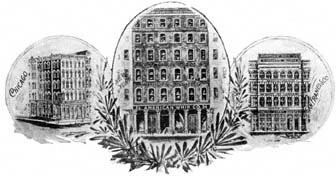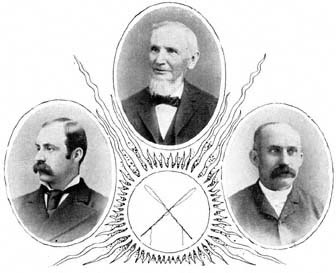 Office of the American Whip Company.
Office of the American Whip Company.
|
There is interesting on account of its ingenuity, around whizz the sticks and on coils the rope with a tightness of grip that would give points to a boa constrictor. In this rope they remain until dry. A little matter of a barrel of glue a day is required for this work, while two hundred and fifty tons of rope a year is alone sufficient for the winding act. But, then, five thousand pounds of rattan a day are served up to feed the maw of this voracious glue tank! Great, isn’t it?
These "stocks" are a very rough, gummy looking lot of sticks when the rope is unwound and it is now requisite that they he smoothed. This is done in a turning lathe. They emerge looking quite fine, but they have got to be woven about, later on, with threads of many colors, so the surface must be nearer like polished metal. In they go the second time, into a "rounder." It Would make the whip cost too much to have a nurse follow it through all the stages of its infancy, so a Whip genius invented for the American Whip Company an automatic "rounder." An armful of these sticks are stood up within reach of the "rounder," a belt is shifted on, the man goes away and
THE "ROUNDER" DOES THE REST.
The "stock" is now ready to go up stairs. It is smoothed, it has its appointed quantity of whalebone or rawhide, and it now requires a suitable covering.
This is given it by the plaiting machine. It would be as useless to attempt description of this intricate mechanism as to try to skate in July. Moreover, any one attempting to explain the machine room would rupture the larynx. It is as noisy as a political primary in a tough ward. But the work is beautiful!
Again the whip gets a rounding and a polishing until the thread covering becomes as smooth as glass and
AS HARD AS THE WESTMINISTER CATECHISM.
It passes through a number of manipulations to secure these qualities. But it is not glossy and pretty as you see it in the store. This finish is had by varnishing. But before this it has a "button" woven on it if it should demand that style of finish.
Here the young ladies come to the front, and by their deftness of finger weave on what is called a button, but which we should say was linen thread glued into strips that look like nothing so much as shavings of whalebone. These buttons are what you admire as ornaments near the butt of the whip, and further up the stock so placed as to define the handle.
At this point the order for that hundred dozen has become scattered all over the works, because the finish and ornaments called for are various.
While the buttoning is going on some others require metal "caps" and "ferules."
Off in one corner is a little factory that is doing business on its own account. Here the metal, precious and common, is spun up, impressed by steel dies carrying a multiplicity of patterns, and made into ferules and caps.
There are thousands of dollars’ worth of property in expensive dies. and the precious metals here worked up, and
ALL IN THE SOLE INTEREST OF ORNAMENTS.
Sometimes it is expensive to please the eye in whips as in other things.
These ornaments are applied and again this simple whip is treated tc waterproofing and varnishing, and hung up by its neck for a long dry.
I forgot to say that damp is the kind of grippe that is fatal to whips And somewhat ahead of the processes last described, it is treated for damp by practitioners of experience.
No fond mother could rear up its child any more carefully than is this whip encased in buckskin, or rawhide or metal foil to keep the damp away from the interior. No lead filling waterproofing, varnishing, is omitted that will stand between "its little in sides" and the cold, cold world.
It is truly wonderful, when you think of it, what you buy in a dollar whip!
Finally it is ready for the snap. A snap is a simple thing - to look at It would astonish you to know the it formerly gave the whip maker. After he learned the trick of weaving it, it had to be learned to put it on so that it would stay put. Tie it, you say. Certainly, and that is what they did. But it had an unpleasant habit of coming untied and dropping off. Here again the ingenious mind got in its fine work. An old employe studied the problem, and by a simple little turn and twist of the snap or lash made a peculiar knot that will wear out a whip in durability.
An interesting circumstance about this great factory is called to mind by the snap incident. It is the fact that whole families have, in some instances, to the second and third generation, been employed in this one factory, and thus
LONG AND INTELLIGENT FAMILIARITY
 American Whip Company—Officers.
American Whip Company—Officers.
|
with whip making has led to the overcoming of obstacles, the invention of devices and machinery that could hardly otherwise have seen the light. Who can say how far we would have been from the twenty-five-cent whip, but for this intelligent Yankee thought that is never content unless "improving" something?
The whips on my order are now beginning to come into the reservation down stairs in dozens, and are being accounted for by their tags and a perfect record that appears in a book in the shipping room. They have been labeled with fancy names, meantime; some even have the name of the dealer to whom they are going woven in by the deft fingers of those young ladies who are so expert at "buttoning," and now, by quarter dozens, they are wrapped in manilla papers, assembled, marked, boxed and shipped.
I return to the office with the tag I started out with, the tag now looking like Jacob’s coat of many colors, and I rest myself by asking a few simple questions. I want to know, for instance,
HOW MANY DIFFERENT STYLES OF WHIPS
the American Whip Company make. I am told upward of one thousand. I also want to know the greatest number of whips finished in one day; that is, bow many come out of the factory, ready to ship. The answer is 1,226 dozen, that 4,200 dozen come out in a week, and 15,000 dozen in a month.
I thought I bad enough of statistics, the figures were getting too bewildering; but I feel sure all who read of what I saw, when next they see, buy, handle or sell a whip, will have a higher regard for the genius that could make its existence possible.
C.H.E.R.
In closing the pages devoted to this most remarkable corporation, it may be of interest to many to know the names of men not already mentioned, who assist in directing its affairs. The New York store is under the management of W.J. Cassard, also a director of the company, with N.J. Davis, T.J. Horan and J.H.B. Dawson on the road, assisted in the office by George Wright as bookkeeper.
The Chicago store is presided over by W.C. Pease, also director (a veteran salesman), with L.W. Jones whose headquarters are at St. Paul, Mich.; Chas. F. Clark of Belvidere, Ill.; W. F. Baker, Greenville, Ohio; J. A. St. Clair, Kansas City, Mo.; W.E. Hall, Evanston, Ill.; F.S. Clements, Jackson, Mich., with C.W. Cleveland in charge of the office.
The San Francisco house is managed ably by the Keystone Brothers, who were formerly in the employ of the company in their boyhood, at Westfield.
The traveling salesmen are Curtis Nelson (over forty years a traveler and stockholder of the company); D. F. Dunham, Boston, Mass., F. A. Nelson, Buffalo, N. Y., D. R. Putnam of Brandon, Vt.
For the past five years the officers and directors of the company have been: L.R. Norton, Hon. E.B. Gillett, D.L. Gillett, Horace W. Avery, S.F. Shepard, D.C. Hull, L.M. Osden, R.T. Sherman, Lewis Parker, Ira Miller, all of Westfield, Mass.; W. Pease, Chicago, Ills.; C.W. Darling and W.J. Cassard of New York.
© Laurel O’Donnell 1996 - 2006, all rights reserved
This document may be downloaded for personal non-commercial use only
and may not be reproduced or distributed without permission in any format.
This is an edited adaptation from the original publication.
|